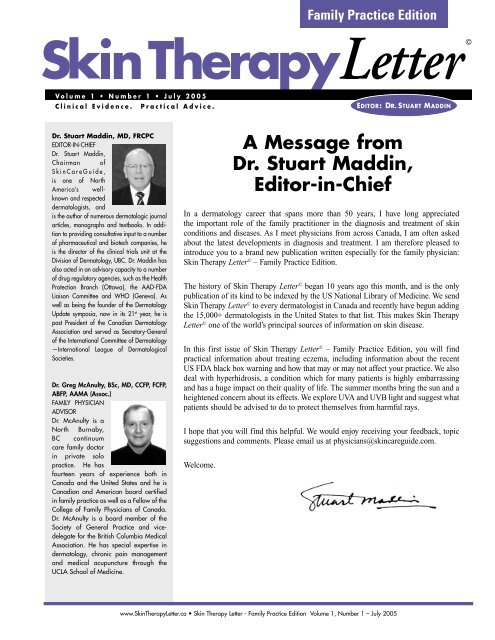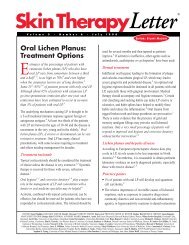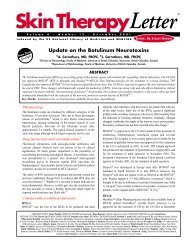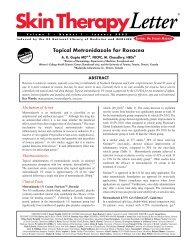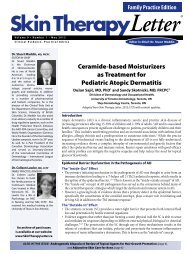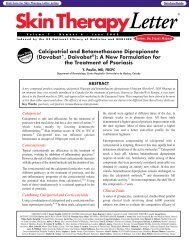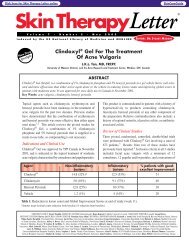PDF English - Skin Therapy Letter
PDF English - Skin Therapy Letter
PDF English - Skin Therapy Letter
Create successful ePaper yourself
Turn your PDF publications into a flip-book with our unique Google optimized e-Paper software.
Family Practice Edition<br />
V o l u m e 1 • N u m b e r 1 • J u l y 2 0 0 5<br />
C l i n i c a l E v i d e n c e . P r a c t i c a l A d v i c e .<br />
Dr. Stuart Maddin, MD, FRCPC<br />
EDITOR-IN-CHIEF<br />
Dr. Stuart Maddin,<br />
Chairman of<br />
S k i n C a r e G u i d e ,<br />
is one of North<br />
America’s wellknown<br />
and respected<br />
dermatologists, and<br />
is the author of numerous dermatologic journal<br />
articles, monographs and textbooks. In addition<br />
to providing consultative input to a number<br />
of pharmaceutical and biotech companies, he<br />
is the director of the clinical trials unit at the<br />
Division of Dermatology, UBC. Dr. Maddin has<br />
also acted in an advisory capacity to a number<br />
of drug regulatory agencies, such as the Health<br />
Protection Branch (Ottawa), the AAD-FDA<br />
Liaison Committee and WHO (Geneva). As<br />
well as being the founder of the Dermatology<br />
Update symposia, now in its 21 st year, he is<br />
past President of the Canadian Dermatology<br />
Association and served as Secretary-General<br />
of the International Committee of Dermatology<br />
—International League of Dermatological<br />
Societies.<br />
Dr. Greg McAnulty, BSc, MD, CCFP, FCFP,<br />
ABFP, AAMA (Assoc.)<br />
FAMILY PHYSICIAN<br />
ADVISOR<br />
Dr. McAnulty is a<br />
North Burnaby,<br />
BC continuum<br />
care family doctor<br />
in private solo<br />
practice. He has<br />
fourteen years of experience both in<br />
Canada and the United States and he is<br />
Canadian and American board certified<br />
in family practice as well as a Fellow of the<br />
College of Family Physicians of Canada.<br />
Dr. McAnulty is a board member of the<br />
Society of General Practice and vicedelegate<br />
for the British Columbia Medical<br />
Association. He has special expertise in<br />
dermatology, chronic pain management<br />
and medical acupuncture through the<br />
UCLA School of Medicine.<br />
In a dermatology career that spans more than 50 years, I have long appreciated<br />
the important role of the family practitioner in the diagnosis and treatment of skin<br />
conditions and diseases. As I meet physicians from across Canada, I am often asked<br />
about the latest developments in diagnosis and treatment. I am therefore pleased to<br />
introduce you to a brand new publication written especially for the family physician:<br />
<strong>Skin</strong> <strong>Therapy</strong> <strong>Letter</strong> © – Family Practice Edition.<br />
The history of <strong>Skin</strong> <strong>Therapy</strong> <strong>Letter</strong> © began 10 years ago this month, and is the only<br />
publication of its kind to be indexed by the US National Library of Medicine. We send<br />
<strong>Skin</strong> <strong>Therapy</strong> <strong>Letter</strong> © to every dermatologist in Canada and recently have begun adding<br />
the 15,000+ dermatologists in the United States to that list. This makes <strong>Skin</strong> <strong>Therapy</strong><br />
<strong>Letter</strong> © one of the world’s principal sources of information on skin disease.<br />
In this first issue of <strong>Skin</strong> <strong>Therapy</strong> <strong>Letter</strong> © – Family Practice Edition, you will find<br />
practical information about treating eczema, including information about the recent<br />
US FDA black box warning and how that may or may not affect your practice. We also<br />
deal with hyperhidrosis, a condition which for many patients is highly embarrassing<br />
and has a huge impact on their quality of life. The summer months bring the sun and a<br />
heightened concern about its effects. We explore UVA and UVB light and suggest what<br />
patients should be advised to do to protect themselves from harmful rays.<br />
I hope that you will find this helpful. We would enjoy receiving your feedback, topic<br />
suggestions and comments. Please email us at physicians@skincareguide.com.<br />
Welcome.<br />
A Message from<br />
Dr. Stuart Maddin,<br />
Editor-in-Chief<br />
www.<strong>Skin</strong><strong>Therapy</strong><strong>Letter</strong>.ca • <strong>Skin</strong> <strong>Therapy</strong> <strong>Letter</strong> - Family Practice Edition Volume 1, Number 1 – July 2005
Family Practice Edition<br />
Atopic Eczema<br />
J. Bergman, MD, FRCPC and D. R. Thomas, MD, FRCPC<br />
Faculty of Medicine, University of British Columbia, Vancouver, Canada<br />
Diagnostic Features of Eczema or Atopic Dermatitis (AD)<br />
Diagnostic Features of Eczema or Atopic Dermatitis (AD): a chronic relapsing condition in patients with a personal or family<br />
history of atopy. Usually starts before the age of 2 years and usually improves or resolves in older children and adults.<br />
• Itching must be present to make the diagnosis.<br />
• Dry <strong>Skin</strong> is always present.<br />
• Typical Rash Location varies with age of patient. Infants: face usually involved. Diaper area and axilla usually clear.<br />
Extensor arms and legs involved due to friction from crawling. Children 4-10 years: flexures, sides of the neck, earlobes.<br />
• Inflammed <strong>Skin</strong> usually seen.<br />
• Secondary Infection – Staphylococcus aureus very common, molluscum and herpes infections often more extensive.<br />
Treatment: Self-help and Medical Treatments<br />
1. Patient Self-help – Patients may not improve if triggers are not removed<br />
Aggravating/Trigger Factors to be Avoided<br />
• <strong>Skin</strong> irritants such as soap, bubble bath, detergents, fabric softeners and perfumed products.<br />
• Frequent bathing, especially if not followed by moisturizers. Sweating may exacerbate pruritus.<br />
• <strong>Skin</strong> infection will tend to promote AD<br />
• Food allergies can play a role in a small percentage of young patients with AD (e.g. eggs, milk, nuts, peanuts, fish, shellfish,<br />
wheat, and soy account for over 90% of food allergies)<br />
• Environmental allergens such as house dust mites<br />
Self-Help<br />
1. Use a mild cleanser; 2. Moisturize often; 3. Hydrocortisone; 4. Cool bathing; 5. Use perfume free products; 6. Oral antihistamines;<br />
7. Avoid triggers<br />
Mild Cleansers<br />
• Mild soap or nonsoap cleanser like Spectrojel ® , Spectroderm ® , Cetaphil ® , plain white Dove ®<br />
• Emulsifying ointment USP (ask pharmacist)<br />
Moisturizers<br />
Use at least 250mg of cream/ week. Must be thick like butter or greasy like petroleum (e.g., Vaseline ® Petroleum Jelly,<br />
Aquaphor ® ointment, Creamy Vaseline ® , 25% water in Hydrophilic Petrolatum, Aqueous cream, Aveeno ® cream, unscented<br />
cold cream, Eucerin ® cream, Cetaphil ® cream, Cliniderm ® cream)<br />
2. Medical Treatment<br />
Relief and suppression of eczema flares check list:<br />
✓ Itch Relief – Dry <strong>Skin</strong> <strong>Therapy</strong> – Inflammation Suppression<br />
with anti-inflammatories<br />
✓ Infection Control<br />
Itch Relief<br />
Oral-sedating antihistamines at bedtime. Hydroxyzine, Benadryl<br />
® , start at low dose and increase as tolerated. Moisturize and<br />
use topical anti-inflammatory. Wet compresses using gauze or<br />
face cloth dipped in tepid water, rung out and then laid on oozing<br />
skin is soothing.<br />
Long-term Control by Preventing New Flares<br />
Control of a flare may be easier than motivating a patient to<br />
continue intermittent use of an anti-inflammatory or to regularly<br />
moisturize the skin and avoid triggers. Using anti-inflammatory<br />
topicals at the first signs and symptoms can minimize the<br />
use of medication and give smoother control of the disease.<br />
Dry <strong>Skin</strong><br />
Frequent moisturizing especially within 2-5 minutes after<br />
bathing and when skin is wet. Most patients under moisturize.<br />
Check the quantity used. Use a minimum of 250mg/week<br />
(more if possible).<br />
Anti-inflammatory Drugs<br />
Corticosteroids and Calcineurin inhibitors are useful for shortand<br />
long-term use.<br />
Topical Corticosteroids (TCS)<br />
• Gold standard of treatment for AD<br />
• Quick acting anti-inflammatory action. Potency from mild<br />
2<br />
www.<strong>Skin</strong><strong>Therapy</strong><strong>Letter</strong>.ca • <strong>Skin</strong> <strong>Therapy</strong> <strong>Letter</strong> - Family Practice Edition Volume 1, Number 1 – July 2005
Treatment: Self-help and Medical Treatments (continued)<br />
to very potent.<br />
• General rule is that one uses the lowest potency possible<br />
for control of the disease. Goal is to be off the steroid more<br />
often than on the steroid.<br />
• Useful for flare prevention.<br />
• In conjunction with calcineurin inhibitors, they have a role<br />
as rescue medication when severe flares develop.<br />
• Low potency corticosteroids are best used in the skin folds,<br />
face and neck.<br />
• Moderate potency steroids are needed for thick lichenified<br />
eczema in older children and for acute flares on the body.<br />
• Side-effects such as skin atrophy, tachyphlaxis, and adrenal<br />
suppression can occur but these are usually seen<br />
if the drug is used for too long, too often, or too much<br />
especially on the face folds, or inner thigh. Very young<br />
and old patients are more at risk. No harm will come<br />
from using potent corticosteriods for short periods, i.e.,<br />
days at a time.<br />
• Two issues of concern are steroid phobia by patients and<br />
steroid allergy:<br />
a) Steroid phobia — patients need to understand that the<br />
body naturally produces steroids and that side-effects are<br />
unlikely if topical steroids are used appropriately.<br />
b) Steroid allergy – Uncommon. Patch testing is required<br />
to confirm.<br />
If a patient is not responding to a topical steroid, as you would<br />
expect, consider compliance, secondary infection, or an allergy<br />
to the medication.<br />
Topical Calcineurin Inhibitors<br />
Pimecrolimus (Elidel 1% cream)<br />
Nonsteroid approved for short- and long-term intermittent use<br />
in mild-to-moderate AD over 2 years of age. Guidelines suggest<br />
use when other standard treatments fail or there is concern<br />
regarding risk of side-effects.<br />
• Rapid relief (1-2 weeks) due to targeted anti-inflammatory<br />
action<br />
Authors' Comments<br />
Recently asked question: What is the role of calcineurin inhibitors<br />
in the control of eczema following the recent FDA<br />
Health Advisory<br />
It is the authors' opinion that the recent Advisory about calcineurin<br />
inhibitors increasing the risk of cancer is based more<br />
on fear than fact. Granted that long-term use of oral immunosuppressive<br />
agents, such as in the transplant population, does<br />
raise the incidence of lymphoma, the degree of suppression is<br />
dose related. Rates of lymphoma and skin cancers in clinical<br />
trials and postmarketing surveillance reveal cancer rates that are<br />
much lower than would be expected in a control population. Evidence<br />
shows that both pimecrolimus and tacrolimus have very<br />
low systemic absorption when used topically as recommended<br />
for AD. Animal studies using oral formulations showed a higher<br />
rate of lymphoma, but at very high doses.<br />
• Used in practice to bring AD under control and also intermittently<br />
thereafter at first signs and symptoms of disease<br />
activity to prevent flare-ups. Topical corticosteroids can<br />
also be used but some physicians reserve them for more<br />
severe flares.<br />
• Well-controlled studies in infants, children and adults<br />
demonstrate significant reduction in incidence of flares<br />
with the use of corticosteroids.<br />
• Long-term studies show efficacy and safety in infants from<br />
3-23 months, but it is not approved for this age range.<br />
• Burning or stinging can be a problem but the likelihood is<br />
usually relative to disease severity. Patients do much better<br />
if warned of this transient effect.<br />
• Long term safety – see Author’s Comment on recent FDA<br />
advisory.<br />
Tacrolimus (Protopic 0.03% and 0.1%ointment)<br />
Non-steroid approved for short-term intermittent use in moderate-to-severe<br />
atopic AD over 2 years of age (0.03% >2yrs,<br />
0.1% >15yrs). Guidelines suggest use when other standard<br />
treatments fail or concern regarding risk of side effects.<br />
• Rapid relief (1-2 weeks) due to targeted anti-inflammatory<br />
action<br />
• Used in practice to bring AD under control and also intermittently<br />
thereafter at first sign of disease activity or flare.<br />
TCS could be used as rescue medications for severe flares<br />
• Long-term studies show safety and efficacy in > 2yr old.<br />
• Burning or stinging can be a problem but the likelihood is<br />
usually relative to disease severity.<br />
• Long term safety – see Author’s Comment on FDA advisory.<br />
Infection Control<br />
Clinical experience shows that AD may respond to anti Staph<br />
antibiotics even when there are no signs of a typical impetigo.<br />
Localized AD with probable secondary infection (swab if in<br />
doubt) use mupirocin cream, fucidic acid cream/ointment or<br />
oral cloxacillin or cephalosporin if widespread.<br />
What is clear is that people with AD have very significant disease<br />
that impacts most negatively on their quality of life. For<br />
the physician and patient there is no option other than to treat<br />
this disabling condition. With any medication there are always<br />
potential risks, but based on the available information the benefits<br />
of these medications far outweigh the risks. Resistant<br />
cases have been treated with UV light, azathioprine, cyclosporine,<br />
mycophenolate mofetil and systemic steroids.<br />
It is significant that in a recent survey of leading dermatologists<br />
in North America and Europe conducted and published<br />
by <strong>Skin</strong> <strong>Therapy</strong> <strong>Letter</strong> © the majority of these doctors reported<br />
that they will not change their habit of prescribing topical calcineurin<br />
inhibitors, but are now likely to spend a little more<br />
time counseling and informing their patients who show concern.<br />
www.<strong>Skin</strong><strong>Therapy</strong><strong>Letter</strong>.ca • <strong>Skin</strong> <strong>Therapy</strong> <strong>Letter</strong> - Family Practice Edition Volume 1, Number 1 – July 2005 3
Family Practice Edition<br />
Hyperhidrosis<br />
N. Solish, MD, FRCPC and C. Murray, MD, FRCPC<br />
Department of Medicine, University of Toronto, Toronto, Canada<br />
Hyperhidrosis is characterized by sweating in excess of the physiological needs to maintain thermal homeostasis. No formal<br />
definition exists but for practical purposes any degree of sweating that interferes with activities of daily living, can be viewed<br />
as hyperhidrosis. The cause is unknown, however treatment options do exist. This disease is much more common than once<br />
thought and greatly impacts upon quality of life (QOL). Treating these patients can be exceptionally rewarding both for the<br />
patient and the physician.<br />
Topical Treatment<br />
Controls mild disease<br />
Botulinum Toxin A (BTX-A) Effective [Naumann M, Hamm H, Lowe NJ. Br J Dermatol 147:1-9 (2002a); Naumann M,<br />
Lowe NJ, Kumar CR, Hamm H. Arch Dermatol 139:731-6 (2003); Lowe NJ, Yamauchi PS,<br />
Lask GP, Patnaik R, et al. Dermatol Surg 28(9):822-7 (2002).]<br />
Iontophoresis Effective [Reinauer S, Neusser A, Schauf G, Hölzle E. Br J Dermatol 129:166-9 (1993).]<br />
Surgery<br />
Considered only after all other options have failed due to potential complications.<br />
[Zacherl J, Huber ER, Imhof M, et al. Eur J Surg 580(suppl):S43-6 (1998).]<br />
Table 1: Treatment options for hyperhidrosis<br />
Epidemiology and Etiology<br />
In a recent survey of 150,000 households in the US, 2.8%<br />
of the population reported having unusual or excessive<br />
sweating.[Strutton DR, Kowalski JW, Glaser DA, Stang PE.<br />
Presented at the American Academy of Dermatology 61st<br />
Annual Meeting, San Francisco CA.] The axilla is the most<br />
common affected site, followed by the feet, palms and face.<br />
No gender differences were noted and onset typically occurred<br />
during childhood or adolescence. The exact cause of focal hyperhidrosis<br />
is unknown, although sympathetic overstimulation<br />
of normal eccrine glands is the most likely etiology. Interestingly,<br />
studies have shown an association between the sympathetic<br />
hyperactivity seen in hyperhidrosis with other autonomic<br />
disorders such as cardiac hyperexcitability. There is likely<br />
also a heritable component to this neurogenic overactivity, as<br />
30%-50% of patients have a positive family history.[Haider A,<br />
Solish N. CMAJ 172(1):69-75 (2005 Jan 4).]<br />
Hyperhidrosis Type<br />
Primary (idiopathic)<br />
Secondary<br />
Clinical Presentation<br />
Focal – localized to the axillae, palms,<br />
feet, face<br />
Generalized, though it can present in a<br />
localized, focal pattern.<br />
Table 2: Clinical Presentation of hyperhidrosis<br />
Impact on Quality of Life<br />
Hyperhidrosis has a profound impact on social interactions<br />
and work related activities. Routine social interactions such as<br />
holding hands, shaking hands or hugging become awkward.<br />
Patients report a sense of humiliation and embarrassment associated<br />
with soaked or stained clothing as well as perceived<br />
odours.[Naumann M, Hamm H, Lowe NJ. Br J Dermatol<br />
147:1-9 (2002a); Haider A, Solish N. CMAJ 172(1):69-75<br />
(2005 Jan 4).]<br />
Drugs/Toxins<br />
Cardiovascular<br />
Respiratory Failure<br />
Neurologic<br />
Endocrine<br />
Infections<br />
Malignancies<br />
Alcoholism, substance abuse<br />
Heart failure, shock<br />
Parkinson’s disease, spinal cord injury, cerebrovascular<br />
accident<br />
Hyperthryroidism, diabetes mellitus, pheochromocytoma,<br />
carcinoid syndrome, acromegaly,<br />
pregnancy, menopause<br />
Hodgkin’s disease, myeloproliferative disorders<br />
Table 3: Etiology of secondary hyperhidrosis<br />
Diagnosis and Patient Evaluation<br />
A history focussing on the location of excessive sweating, duration<br />
of the presentation, associated symptoms or comorbidities,<br />
family history, age of onset and any specific triggers allows one to<br />
differentiate primary from secondary hyperhidrosis. The physical<br />
exam will be guided by any suggestion of secondary hyperhidrosis,<br />
and will also attempt to confirm the distribution of disease.<br />
Measurement of Hyperhidrosis<br />
Each evaluation should attempt to determine the volume of sweat<br />
production, the distribution of hyperhidrosis and the affect on<br />
QOL. The starch iodine test provides a qualitative assessment of<br />
both volume of sweat production and extent of distribution.<br />
• The area to be tested is dried and an iodine solution (1%-5%)<br />
is applied.<br />
• After a few seconds, starch is sprinkled over this area.<br />
• The starch and iodine interact in the presence of sweat to develop<br />
a purplish sediment.<br />
This test is most helpful when delineating the area for treatment.<br />
To assess impact on QOL, various measures have been validated,<br />
such as the hyperhidrosis disease severity scale (HDSS). (Table 2)<br />
4<br />
www.<strong>Skin</strong><strong>Therapy</strong><strong>Letter</strong>.ca • <strong>Skin</strong> <strong>Therapy</strong> <strong>Letter</strong> - Family Practice Edition Volume 1, Number 1 – July 2005
My sweating is never noticeable and never interferes<br />
with my daily activities.<br />
My sweating is tolerable but sometimes interferes<br />
with my daily activities.<br />
My sweating is barely tolerable and frequently interferes<br />
with my daily activities.<br />
My sweating is intolerable and always interferes<br />
with my daily activities.<br />
Score 1<br />
Score 2<br />
Score 3<br />
Score 4<br />
Table 4: Hyperhidrosis Disease Severity Scale (HDSS) is<br />
a four-point scale to determine the degree of severity of<br />
hyperhidrosis.<br />
Topical Treatments for Hyperhidrosis<br />
Aluminum chloride hexahydrate is considered to be the most<br />
effective topical agent for focal, mild axillary hyperhidrosis. It<br />
works through mechanical obstruction of the eccrine sweat gland<br />
pore. Another topical product is glycopyrrolate, a topical anticholinergic<br />
product available as topical pads for mild cases. The main<br />
limiting side-effects of all of these products are skin irritation,<br />
lack of efficacy in moderate-to-severe axillary hyperhidrosis, and<br />
poor response on the palms and soles.<br />
Systemic Treatments<br />
In addition to glycopyrrolate mentioned in Table 5, other agents such as clonazepam, diltiazem, clonidine and nonsteroidal<br />
anti-inflammatories have been reported to be useful in isolated cases.<br />
TREATMENT INDICATION COMMENTS<br />
Topical treatments Axillary, facial, less commonly palmar Short term action. Efficacy in mild cases. Major side effect is local irritation.<br />
and plantar hyperhidrosis<br />
Palms and soles less responsive<br />
Systemic treatments,<br />
e.g., glycopyrrolate<br />
Table 5: Hyperhidrosis treatment options<br />
Main role in generalized and compensatory<br />
hyperhidrosis.<br />
Limited efficacy due to anticholinergic side-effects, e.g., dry mouth, blurred<br />
vision, constipation, urinary retention, palpitations.<br />
Iontophoresis Palmar and plantar hyperhidrosis Well tolerated. Dryness and irritation are common. Efficacy can reach 90%.<br />
Major limitations are the equipment expense and procedure is time consuming<br />
Surgical sympathectomy<br />
Botulinum toxin<br />
injections<br />
Hyperhidrosis unresponsive to topical<br />
or systemic treatment and BTX-A<br />
Axillary, palmar, plantar and facial<br />
hyperhidrosis<br />
Treatments Considerations with Botulinum Toxin<br />
Major limitation is possible surgical adverse events and an unacceptable high rate of<br />
compensatory hyperhidrosis. ETS surgery should be considered as a last resort.<br />
Commonly used for moderate-to-severe disease or if mild cases do not respond<br />
to topical treatment. Safe, effective and well-tolerated treatment with excellent<br />
patient satisfaction. Drug usually covered by third party insurance.<br />
The main contraindications to botulinum toxin therapy include neuromuscular disorders such as myasthenia gravis, pregnancy and lactation, organic<br />
causes of hyperhidrosis, and medications that may interfere with neuro-muscular transmission. [Haider A, Solish N. CMAJ 172(1):69-75 (2005 Jan 4).]<br />
Appropriate selection of patients is essential to ensure a satisfactory treatment response and avoid unnecessary frustrations.<br />
Condition Results Side-effects Comments<br />
Axillary hyperhidrosis [Naumann M, Hamm<br />
H, Lowe NJ. Br J Dermatol 147:1-9 (2002a);<br />
Naumann M, Lowe NJ, Kumar CR, Hamm H.<br />
Arch Dermatol 139:731-6 (2003); Solish N,<br />
Benohanian A, Kowalski JW. Dermatol Surg<br />
31(4):405-13 (2005 Apr).]<br />
Palmar hyperhidrosis [Lowe NJ, Yamauchi<br />
PS, Lask GP, Patnaik R, et al. Dermatol<br />
Surg 28(9):822-7 (2002).]<br />
Plantar hyperhidrosis [Haider A, Solish N.<br />
CMAJ 172(1):69-75 (2005 Jan 4).]<br />
Facial hyperhidrosis [Haider A, Solish N.<br />
CMAJ 172(1):69-75 (2005 Jan 4).]<br />
Table 6: Review of BTX-A treatment to focal areas.<br />
>90% response<br />
rates with statistically<br />
significant<br />
improvements in<br />
QOL<br />
>90% response<br />
rates<br />
Excellent response<br />
rates have<br />
been reported<br />
Clinically significant<br />
improvements<br />
seen<br />
Safe, well<br />
tolerated<br />
Pain at the site of injection;<br />
transient minor<br />
weakness of intrinsic<br />
hand muscles lasting<br />
2-5 wks.<br />
Pain at the site of<br />
injection<br />
Typical starting doses are 50 units of BTX-A<br />
per axilla. The mean duration of effect is 6–7<br />
months.<br />
Treatment consists of 100 units per palm. Intradermal<br />
injection into the palm is painful, so anesthesia<br />
is strongly recommended. Regional nerve<br />
blockade (median and ulnar) is most commonly<br />
used. Topical anesthesia is ineffective.<br />
Treatment doses and technique are similar to<br />
the palms, occasionally requiring a higher dose.<br />
Regional nerve block is generally required for anaesthesia<br />
and involves the posterior tibial and aural<br />
nerves. Duration of effect is 4-6 months.<br />
Forehead is most common affected area with<br />
the main site of injection being a band along the<br />
hairline, extending into the temporal scalp. Can<br />
also involve the upper lip, nasolabial folds, malar<br />
regions. Duration of effect is 5-6 months.<br />
www.<strong>Skin</strong><strong>Therapy</strong><strong>Letter</strong>.ca • <strong>Skin</strong> <strong>Therapy</strong> <strong>Letter</strong> - Family Practice Edition Volume 1, Number 1 – July 2005 5
Family Practice Edition<br />
UVA and UVB light have different characteristics.<br />
<strong>Skin</strong> Conditions and the Sun<br />
D. R. Thomas, MD, FRCPC<br />
Faculty of Medicine, University of British Columbia, Vancouver, Canada<br />
The skin has evolved to protect us from the harmful effects of ultraviolet light. Sunscreens were first developed to prevent sunburns<br />
by blocking UVB; they allowed us to prolong our time in the sun, but that resulted in increased exposure to UVA. Most modern sunscreens<br />
attempt to block the whole spectrum of UV light, however not all so-called broad spectrum sunscreens protect skin from the<br />
whole range of UVA.<br />
A Comparison on UVA and UVB<br />
Comparisons UVA (320-400nm) UVB (290-320nm)<br />
Levels Levels are constant throughout the year Amounts vary and increase in the summer, at noon, and on the equator<br />
Penetration Penetrates into the lower dermis Most only penetrates the epidermis<br />
Levels through glass Penetrates glass Does not go through glass<br />
Other 95% of UVL is UVA SPF of sunscreens only measures UVB blockage<br />
Table 1: Comparison of UVA and UVB light<br />
Effects on the <strong>Skin</strong> UVA* UVB<br />
Carcinogenic level May be important in causing melanoma More carcinogenic than UVA<br />
Changes to the skin<br />
• Tans the skin<br />
• Causes most of the aging effects seen in the skin<br />
Sunburns the skin<br />
Systemic Effects Immunosuppressive Needed for Vitamin D production<br />
Other effects<br />
Table 2: Effects on the skin.<br />
• Phototoxic reactions to drugs and chemicals<br />
• Responsible for many photodermatoses<br />
*It should be noted that sun-tanning beds use mainly UVA light. There is no such thing as a “safe” suntan. Recently the US FDA began investigating<br />
whether suntan beds should be illegal for anyone under the age of 18 years.<br />
Long-term Effects on the <strong>Skin</strong><br />
Most of us know that sun exposure has immediate positive and negative<br />
effects on the skin. The medium and longer term effects are negative.<br />
Positive effects include a sense of warmth, pleasure and Vitamin D<br />
production.<br />
Short-term effect<br />
Negative Effects:<br />
• Sunburn, or tan<br />
• Photosensitive rashes<br />
• Drug and chemical<br />
phototoxicity and<br />
allergy reactions<br />
• Light aggravated<br />
conditions<br />
Medium-term<br />
effect<br />
Negative Effects:<br />
• Photodamage<br />
• Photoaging<br />
Long-term<br />
effect<br />
Negative Effects:<br />
• <strong>Skin</strong> cancer<br />
• Photoaging<br />
Photosensitive Rashes<br />
These occur only when activated by UV light. Most of them are<br />
brought on by UVA. Photosensitive rashes (detailed below) can be<br />
thought of as:<br />
1 – Idiopathic reactions to UV light<br />
(Polymorphous light eruption - PLE)<br />
The timing of the onset of the rash in relation to sun exposure and its<br />
duration, as well as the type of reaction produced on the skin, is key to<br />
making the diagnosis. As always there is some variation.<br />
2 – Phototoxic and photoallergic skin reactions<br />
There are a number of drugs and chemicals that can produce a reaction<br />
in the skin. These can be either phototoxic or photoallergic reactions.<br />
3 – UV aggravation of existing conditions<br />
There are many pre-existing conditions that are aggravated by sunshine.<br />
Some of the important light aggravated conditions are:<br />
• Rosacea<br />
• Seborrehic dermatitis<br />
• Melasma<br />
• Discoid lupus<br />
• Dermatomyositis<br />
• Herpes simplex<br />
• Viral Exanthem<br />
• Pemphigus<br />
• Darier’s disease<br />
• Porphyrias<br />
• Systemic lupus erythematosus (SLE)<br />
6<br />
www.<strong>Skin</strong><strong>Therapy</strong><strong>Letter</strong>.ca • <strong>Skin</strong> <strong>Therapy</strong> <strong>Letter</strong> - Family Practice Edition Volume 1, Number 1 – July 2005
Polymorphous Light Eruption<br />
Sun Exposure Causes<br />
• Rash starts within hours of exposure<br />
and lasts for days even<br />
with no further sunshine. Solar<br />
urticaria is seen within minutes<br />
of exposure.<br />
• Rash can be seen in the form<br />
of papules, papulovesicles or<br />
plaques, hence the term polymorphous.<br />
• Plaques are less commonly<br />
seen.<br />
Polymorphous light eruption (PLE)<br />
• Mostly caused by UVA<br />
• Occurs in early spring or summer, and often during<br />
vacation periods<br />
• Is mostly symmetrical, red papules and plaques.<br />
• Occurs in exposed areas but not necessarily all the<br />
exposed areas<br />
• Occurs in 10%-20% of the population<br />
• May be confused for allergic reaction to sunscreen<br />
• <strong>Skin</strong> tends to be less reactive to sun as the summer<br />
progresses.<br />
• The type of rash tends to remain constant for each patient.<br />
Treatment of PLE<br />
• Sun avoidance and protection with<br />
broad spectrum sunscreen (UVA<br />
and UVB)<br />
• Topical steroids and antihistamines<br />
• UVA and UVB light therapy may<br />
help some at the start of the season,<br />
which can harden the skin and<br />
prevent the reaction.<br />
• Hydroxychloroquine, 400mg daily<br />
for 2 weeks in the spring or before a<br />
vacation may help<br />
Photoxic vs. Photoallergic Reactions<br />
Phototoxic drugs or chemicals<br />
• Sunburn-like<br />
• Usually seen within hours<br />
• Usually caused by UVA<br />
Includes tetracyclines, sulfa,<br />
amioderone, fursomide, naproxen,<br />
piroxicam, chlorpromazine,<br />
ciprofloxacin, thiazides<br />
Photoallergic reactions<br />
• An eczema like reaction. Can be thought of as a delayed hypersensitivity type reaction.<br />
• Causes: Sunscreens, fragrances/aftershave (like musk ambrette, sandalwood oil), chlorhexidine<br />
Phytophotodermatitis<br />
• A special type of reaction to topical contact with a sensitizer called psoralen contained in a number of plants.<br />
• UVA plus psoralen will produce a blistering reaction often seen in streaks; a brown pigmentation is produced<br />
which may last for months.<br />
• Plants containing psoralen are responsible including lime, yarrow, cow parsley, celery, lemon, fig<br />
Photoprotection<br />
Should be encouraged to prevent the immediate,<br />
medium and long-term ill effects of<br />
excessive sun exposure. Some sun exposure is<br />
desirable for vitamin D production.<br />
Two ways to encourage photoprotection:<br />
1. Sun avoidance<br />
• Avoid the sun between 10am and 3pm.<br />
Sunbed Tan<br />
• Will not give as much protection as a tan<br />
produced by the sun.<br />
• The UVB component of a natural tan produces<br />
a protective thickening of the epidermis,<br />
though the SPF protection is only about<br />
2-6. This protection not found in a UVA tan.<br />
Self-Tanners<br />
Tanners<br />
• Very popular, producing good, even colour.<br />
• Contain dihydroxyacetone (DHA); reacts<br />
with amino acids containing keratin. DHA<br />
concentration varies from 2%-6%; higher<br />
numbers give a darker colour.<br />
• DHA has an SPF of 2%-3%. Some have a<br />
low SPF screen added that lasts only a few<br />
hours.<br />
• Coloured skin does not provide protection<br />
against photodamage.<br />
• Bronzers are dyes that are added to the skin;<br />
can be washed off.<br />
• Beta-carotene, tyrosine, tanning accelerators<br />
such as psoralen are not recommended.<br />
• Try to stay in the shade.<br />
• Wear protective, tightly woven clothes and a<br />
broad brimmed hat.<br />
2. Sun protection<br />
• Use a Broad-spectrum sunscreen in a sufficient<br />
quantity.<br />
• SPF = the ratio of minimal erythema dose<br />
Sunscreen Use<br />
• Broad spectrum only should be used.<br />
• SPF related to UVB protection only; does<br />
not provide a reference to UVA protection.<br />
• All sunscreens have UVB protection;<br />
reflected in the SPF.<br />
• If skin sunburns in 10 minutes, properly<br />
applied sunscreen at SPF 15 means skin will<br />
burn in 150 minutes.<br />
• Physical screens reflect light; chemical<br />
screens absorb UV, converting energy into<br />
heat<br />
• SPF15 blocks 87.5% of UVB and SPF 50<br />
blocks 98% of UVB.<br />
Sunscreen Choices<br />
(MED) of protected skin/MED of unprotected<br />
skin. This is a crude biological measure.<br />
• The SPF factor is calculated using 2mg/cm 2<br />
of sunscreen. Most people apply only<br />
25-50% of this.<br />
• Reapply sunscreen every 2 hours; UVL<br />
causes some chemical sunscreens to become<br />
inactive over time.<br />
Sunscreen with full spectrum UVA protection<br />
contains:<br />
Avobenzone (Parsol 1789), Mexoryl Sx, and<br />
Zinc oxide working together. The first two<br />
have slightly different peaks of protection.<br />
Titanium Dioxide, Dioxybenzone Methyl anthranilate<br />
and Octocrylene provide UVA protection,<br />
but not along the whole spectrum.<br />
Some recommended general sunscreens:<br />
Ombrelle ® 30, 45, 60, cream and lotion.<br />
(This broad spectrum sunscreen was pioneered<br />
in Canada); Anthelios ® 30, 45, 60;<br />
Neutrogena ® Heathy Defense Sunblocks 30,<br />
45 with parsol.<br />
Special sunscreens:<br />
Lip protection: SCC is more commonly seen<br />
in men and women who don’t wear lipstick:<br />
Ombrelle ® Lip Balm SPF30; RoC Minesol ®<br />
Lipstick SPF 20; Neutrogena Stick 30; Antherpos<br />
® SPF 50.<br />
For joggers these can also be used above the<br />
eyebrows to prevent the screen from entering<br />
the eyes. Can also be used on the nose.<br />
Spray for athletes, or for people with hairy or<br />
oily skin: Ombrelle ® Sport Spray 15; Coppertone<br />
® Sport 15 and 30; Neutrogena ® Healthy<br />
Defense Spray 30.<br />
www.<strong>Skin</strong><strong>Therapy</strong><strong>Letter</strong>.ca • <strong>Skin</strong> <strong>Therapy</strong> <strong>Letter</strong> - Family Practice Edition Volume 1, Number 1 – July 2005 7
Get more clinical information at<br />
www.<strong>Skin</strong><strong>Therapy</strong><strong>Letter</strong>.ca<br />
A Physicians' site for:<br />
• A-Details : Online drug presentations on<br />
Accutane ® Aldara ® Amevive ® Bactroban ® Clindoxyl ® Cutivate ®<br />
Diane35 ® Dovobet ® Elidel ® Eumovate ® Penlac ® Soriatane ®<br />
• <strong>Skin</strong> <strong>Therapy</strong> <strong>Letter</strong> © articles<br />
• Meeting Abstracts and Proceedings<br />
• Refer your patients for self-help to www.<strong>Skin</strong>CareGuide.ca<br />
or any of the following sites:<br />
AcneGuide.ca EczemaGuide.ca FungalGuide.ca HerpesGuide.ca<br />
RosaceaGuide.ca <strong>Skin</strong>CancerGuide.ca PsoriasisGuide.ca PsoriaticArthritisGuide.ca<br />
BotoxFacts.ca Lice.ca MildCleanser.ca<br />
We welcome your comments and suggestions. Please email us at physicians@skincareguide.com<br />
This publication has been provided to you through an unrestricted educational grant from the following companies:<br />
Novartis is one of the world’s leading healthcare companies. We are committed to improving the well being of people by creating innovative<br />
products and services in the areas of pharmaceuticals, nutrition, eye-care, and animal health. Each year, Novartis Pharmaceuticals Canada<br />
conducts clinical trials at hundreds of sites across the country, involving thousands of patients, researcher and investigators.<br />
Allergan, Inc. is a global specialty pharmaceutical company that develops and commercializes innovative products for the eye care,<br />
neuromodulator, skin care and other specialty markets.<br />
Ombrelle – Launched in 1990 with the assistance of Canadian dermatologists, Ombrelle has dedicated itself to offer state-of-the-art sun<br />
protection technology in Canada. Recognized by the Canadian Dermatology Association (CDA), Ombrelle continually invests in research<br />
to maintain its leadership in sun protection. As a result, Ombrelle is the sun protection most recommended by Canadian dermatologists and<br />
pharmacists 1 . ( 1 Pharmacy Post, April 2005, Volume 13, Number 4)<br />
Copyright 2005 by <strong>Skin</strong>CareGuide.com Ltd. <strong>Skin</strong> <strong>Therapy</strong> <strong>Letter</strong> © – Family Practice Edition is published quarterly by <strong>Skin</strong>CareGuide.com Ltd, 1107-750 West Pender,<br />
Vancouver, British Columbia, Canada, V6C 2T8. All rights reserved. Reproduction in whole or in part by any process is strictly forbidden without prior consent of the<br />
publisher in writing. While every effort is made to see that no inaccurate or misleading data, opinion or statement appear in the <strong>Skin</strong> <strong>Therapy</strong> <strong>Letter</strong> © – Family Practice<br />
Edition, the Publishers and Editorial Board wish to make it clear that the data and opinions appearing in the articles herein are the responsibility of the contributor.<br />
Accordingly, the Publishers, the Editorial Committee and their respective employees, officers and agents accept no liability whatsoever for the consequences of any<br />
such inaccurate or misleading data, opinion, or statement. While every effort is made to ensure that drug doses and other quantities are presented accurately, readers<br />
are advised that new methods and techniques involving drug usage, and described herein, should only be followed in conjunction with the drug manufacturer’s own<br />
published literature.<br />
www.<strong>Skin</strong><strong>Therapy</strong><strong>Letter</strong>.ca • <strong>Skin</strong> <strong>Therapy</strong> <strong>Letter</strong> - Family Practice Edition Volume 1, Number 1 – July 2005 8


